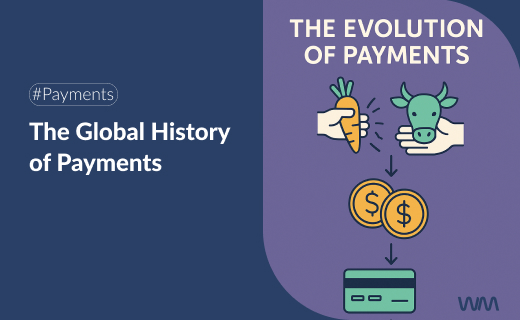Payments: The Lifeblood of Civilization
Payments have always played — and continue to play — a vital role in the development of civilization. From the earliest exchanges of goods to the invisible digital systems seamlessly woven into our daily lives, the history of payments is one of trust, innovation, and efficiency.
At every stage of history, payment systems didn’t just solve practical problems — they opened up new opportunities for economies to grow. Let’s take a look at the major milestones of this remarkable journey.
Barter: The Seed of Commerce
For millennia, exchanges were based on barter — goods for goods. A goat for wheat, salt for fish, cacao for tools. This system worked within small communities but had two major limitations:
-
It required a coincidence of needs between both parties.
-
It lacked a universal standard of value.
As the Bank of England explains, barter was the first step toward money — but it soon became inadequate for more complex societies.
The First Coins: Standardized Value
Around the 7th century BC, in the Kingdom of Lydia (modern-day Turkey), the first coins made of precious metals were minted. This marked a huge leap forward: for the first time, value could be measured and universally accepted.
Metal coins solved the inefficiencies of barter and became the common language of trade. According to the European Central Bank, this standardization enabled long-distance commerce and laid the foundations for the first modern monetary economies.
Paper Money: Lightness and Expansion
In 9th-century China, during the Tang dynasty, the first paper money (jiaozi) appeared. Carrying wealth in paper form was lighter and safer than transporting chests of gold.
Experts note that this shift represented a logistical and financial revolution: money became less tangible but far more practical for trade.
The innovation spread along the Silk Road and, though Europe took centuries to adopt it, it marked the beginning of the fiat money we use today.
Bills of Exchange and the Birth of Medieval Banking
During the Middle Ages, European merchants faced long and dangerous journeys. To avoid the risks of transporting gold — as had been foreseen centuries earlier in parts of Asia — bills of exchange emerged: documents representing a promise of payment in another city.
As noted by the Riksbank (Sweden’s central bank), this innovation gave rise to the first banking institutions and cemented the concept of trust in a written promise.
Credit Cards: The Age of Plastic Money
The next leap came in 1950 with Diners Club — the first modern credit card. It allowed people to pay without cash and settle their debts later.
Soon after came Visa (1958) and Mastercard (1966), expanding the model globally. According to Forbes, these cards triggered a cultural shift: payments were no longer tied to physical money but became electronic promises of credit.
ATMs, Chips, and Contactless
In 1967, Barclays installed the first ATM in London, giving users 24-hour access to cash. In the 1980s, chip cards were introduced, enhancing security.
By 1997, Hong Kong launched Octopus — a pioneer in contactless payments. These advances, documented by BNP Paribas and other European banks, laid the groundwork for today’s seamless payment experience.
The Internet and Payment Gateways
The rise of the internet in the 1990s brought a new challenge: how to pay in a digital environment. Online payment gateways emerged to securely process transactions between merchants and customers.
In 1998, PayPal was founded and soon became a global standard. The World Economic Forum cites this moment as one of the disruptive milestones that transformed global business.
Mobile Payments and Digital Wallets
With the advent of smartphones, money found a new form: the digital wallet. Apple Pay, Google Pay, and Bizum made payments as simple as a tap on the phone — reinforced by biometrics and tokenization.
Meanwhile, in emerging markets, solutions like M-Pesa (2007, Kenya) enabled millions without bank accounts to send and receive money via SMS. The GSMA documents how this system dramatically improved financial inclusion.
Cryptocurrencies and Blockchain
In 2009, Bitcoin introduced the concept of decentralized digital currency based on blockchain. Its founding white paper by Satoshi Nakamoto proposed a system of peer-to-peer electronic cash — with no intermediaries.
Despite its volatility, Bitcoin sparked a global debate on the future of money and the potential for parallel financial systems.
The Future: Invisible Payments and a Frictionless Economy
Today’s trend points toward invisible payments: cars that pay for tolls automatically, subscriptions that renew themselves, or cashierless supermarkets.
The World Economic Forum describes this as a “frictionless economy,” where payments fade into the background — becoming an integrated, almost imperceptible process.
Conclusion
The history of payments is the story of humanity’s constant quest to remove barriers from commerce.
-
From barter to coins: value became universal.
-
From paper money to bills of exchange: trust became portable.
-
From cards to gateways: payments went digital.
-
From wallets to crypto: money became abstract.
And now, toward invisible payments: transactions blending seamlessly into daily life.
The journey continues — how do you think we’ll pay 50 years from now?






